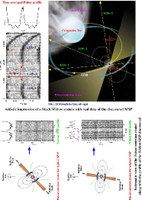GMRT discovery of six exotic millisecond pulsars at the Fermi LAT sky positions
We report the discovery of six exotic millisecond pulsars (MSPs) using the Giant Metrewave Radio Telescope (GMRT), which pushes the boundaries of the known parameter space of MSPs. These unique discoveries made with the GMRT are expected to have huge impact on our understanding of pulsar astrophysics and are important scientific contributions from India.
Milli-Second Pulsars (MSPs) are some of the most fascinating objects in all of astronomy. They are very compact and dense neutron stars -- total mass as much as our Sun, but compressed into a 10-km size object, and they rotate with periods of only a few tens of milliseconds. In August 2008, NASA launched the Fermi Satellite, which has on-board the Large Area Telescope (LAT) instrument for surveying the Gamma-ray sky. One of the spectacular successes of this mission has been the discovery of a large population of Gamma Ray emitting MSPs. An International Pulsar Search Consortium (PSC) was formed to search for millisecond pulsations in the radio band for these sources. Discovery of such gamma-ray selected MSPs, which also emit radio waves, is of great value, not only to enhance the MSP population that can contribute to the study the gravitational wave background, but also to provide much broader window for probing the physics of pulsars.
The Giant Metrewave Radio Telescope (GMRT) is the largest radio telescope in the world operating in the frequency range of 150-1500 MHz and is built and operated by the National Centre of Radio Astrophysics (NCRA) of the Tata Institute of Fundamental Research (TIFR). A team of researchers, led by Dr. Bhaswati Bhattacharyya (who has done Ph.D from NCRA and now working at IUCAA), along with Jayanta Roy from NCRA became active member of the PSC from the end of 2010. In the short span of about one year, this team has discovered six new pulsars. Though there are several other major radio observatories across the world which are part of the PSC, it is due to its unique capabilities at low radio frequencies, that the GMRT has become the frontier in discovering these Fermi MSPs and has contributed as much as 36\% to enhance the MSP population. This remarkable achievement has also been made easier due to two new capabilities : the GMRT Software Back-end -- a state of the art High Performance Computing back-end at the GMRT (developped by Jayanta Roy and colleagues) to collect high time resolution data from the GMRT ; and a powerful High Performance Computing Cluster at IUCAA for the data analysis. In addition to Bhaswati Bhattacharyya and Jayanta Roy, the GMRT discovery team also includes, Yashwant Gupta from NCRA, Dipankar Bhattacharya from IUCAA and Elizabeth Ferrara from Goddard Space Flight Center on behalf of the Fermi PSC.
The six MSPs discovered with GMRT are of diverse and interesting characteristics. These include a 2.16 millisecond period pulsar (named PSR J1544+4937) which is in a very tight binary orbit of 2.8 hours (which is the shortest known among the Fermi MSPs) with a very low-mass star that is one-fiftieth of the mass of the Sun. This pulsar is eclipsed for about 10\% of its orbit by the material of the companion. This pulsar is expected to provide the missing link between isolated and fully recycled pulsars, wherein the strong radiation from the pulsar slowly evaporates away the companion, eventually leaving the neutron star as a single object. Such systems are call Black Widow systems, in analogy with the Black Widow Spider that destroys its companion in the later stage of life! The importance of this discovery can be gauged by the fact that only 2 such systems have been discovered in the disk of our Galaxy in the last 20 years.
The other interesting GMRT discoveries are a 3.08 ms MSP (PSR J1536-49), which has a pulse profile shape that is the widest among the all known MSPs; a 3.63 ms pulsar (PSR J1828+0625) with a feature-less sharp narrow profile, which can be a good candidate for inclusion in International Pulsar Timing Arrays; a 5.85 ms MSP (PSR J1646-2142), which shows profile evolution that is very new and different from the known radio MSPs; and a 4.84 ms MSP (PSR J1207-5050), an isolated pulsar which is at the end for its evolutionary phase of life.
Bhaswati Bhattacharyya and Jayanta Roy have been following up these newly discovered MSPs with the GMRT for detailed timing studies, which will provide accurate enough parameters such that the data from the gamma-ray telescope can be analysed to get the gamma-ray light curves. The comparative study of the radio and gamma-ray light curves can provide powerful methods to probe the pulsar magnetosphere. The current pulsar emission models predict that the high energy emission originates at higher altitudes in the magnetosphere, in contrast to the radio emission that comes from near the surface of the star. But the striking cases of phase alignment of radio and gamma-ray light curves seen in some of the Fermi MSPs indicates that there could be partial co-location of the radio and gamma-ray emission regions. Radio polarization measurements at the GMRT that have been recently proposed by the team, will help to discriminate whether the radio light curve is produced due to the possible caustic nature of the emission, where the emission coming from a large range of altitudes.
Contact:
Bhaswati: 9405610918
Jayanta: 9423577604
Document Actions

